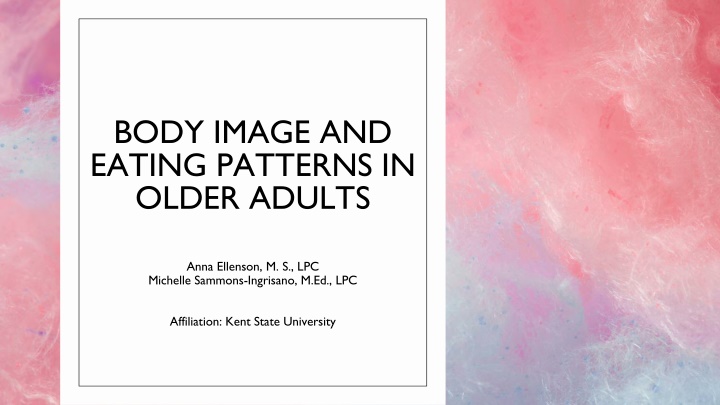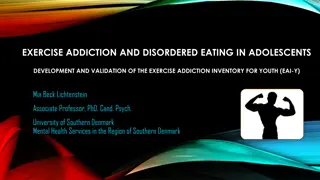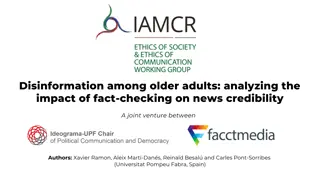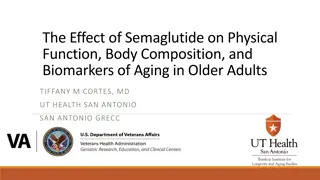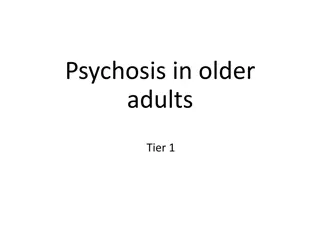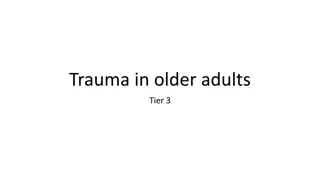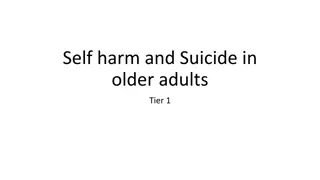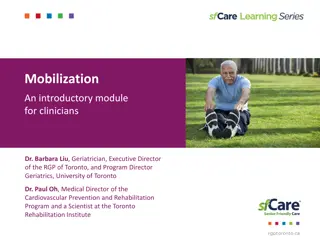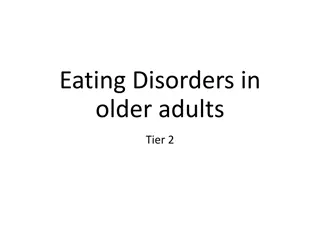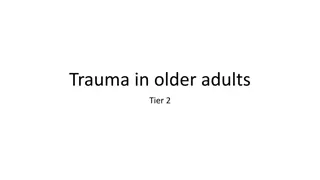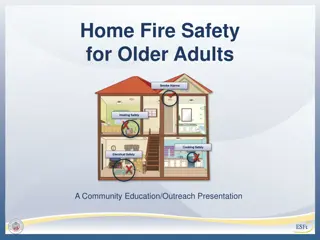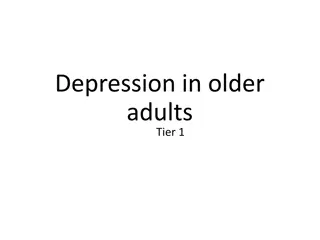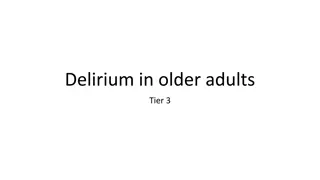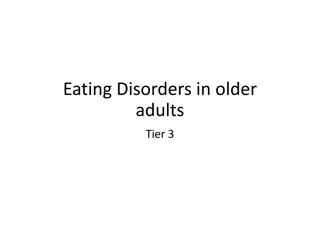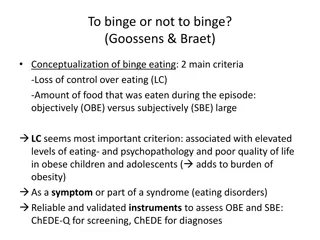Body Image and Eating Patterns in Older Adults Research Study
Older adults' experiences with body image and eating patterns, including the impact of eating disorders, body dissatisfaction, and body dysmorphic disorder on mental health. The study aims to understand the connection between psychological distress and negative body perceptions in the older adult population.
Download Presentation

Please find below an Image/Link to download the presentation.
The content on the website is provided AS IS for your information and personal use only. It may not be sold, licensed, or shared on other websites without obtaining consent from the author.If you encounter any issues during the download, it is possible that the publisher has removed the file from their server.
You are allowed to download the files provided on this website for personal or commercial use, subject to the condition that they are used lawfully. All files are the property of their respective owners.
The content on the website is provided AS IS for your information and personal use only. It may not be sold, licensed, or shared on other websites without obtaining consent from the author.
E N D
Presentation Transcript
BODY IMAGE AND EATING PATTERNS IN OLDER ADULTS Anna Ellenson, M. S., LPC Michelle Sammons-Ingrisano, M.Ed., LPC Affiliation: Kent State University
Research Study Rationale Normative Discontent (Rodin et al., 1985) Previous Research Connection between eating disorders and body image in older adults Quantitative Studies High rate of body dissatisfaction, but limited research Research Question: How do older adults experience body image and eating patterns within their individual lives?
Eating Disorders in Older Adults Eating Disorders: Abnormal eating patterns constituting a medical and mental illness (Lapid et al., 2010). When individuals eat, a food pattern is developed (Furman, 2014). Eating disorders can be difficult to identify in older adults because of co-occurring issues (Lapid et al., 2010)
Eating Disorders in Older Adults Eating disorders have also been found to be co-occurring with other psychological disorders (Franx et al., 2017; Midlarsky et al., 2018): Steady rise in number of older adults seeking treatment for eating disorders (Ackard et al., 2013). Late onset eating disorders Reoccurring eating disorders What does this mean for the counseling profession?
Body Dissatisfaction in Older Adults Body Image: Attitudes toward one s body that includes perceptional, affective, and cognitive components (Midlarsky et al., 2018). Body Dissatisfaction: Psychological distress is based on negative perceptions of one s body, which are commonly associated with weight and/or body shape (Midlarsky et al., 2018). Low Self-Image in older adults (Corning et al., 2006) Anti-Aging Attitudes (Lewis et al., 2011)
Body Dissatisfaction in Older Adults A study conducted by Allaz et al. (1996) found that 62% of women over the age of 65 wanted to lose weight, and that 73% of those individuals were already at a healthy weight. Body Mass Index (Allaz et al., 1996). Body dissatisfaction s impact on mental health (Peat et al., 2008) Media s impact on body image (Peat et al., 2008)
Body Dysmorphic Disorder in Older Adults Body Dysmorphic Disorder: The preoccupation with physical flaws or defects that are invisible or minor to others (American Psychological Association, 2013) Body dysmorphic disorder is an underrecognized disorder, despite being found in about 2% of the population (Phillips, 2014) Insight specifier (Phillips, 2014)
Body Dysmorphic Disorder in Older Adults Summers et al. (2017) Not just right experiences (NJREs) Feelings of incompleteness (INC) correlated with body dysmorphic disorder Treatment (Phillips, 2014) Risk of suicide (Phillips, 2014; Tomas-Aragones & Marron, 2016)
Eating Disorders & Body Dissatisfaction Natural Aging Process (Tomas-Aragones & Marron, 2016). Recognizing eating disorders and body dissatisfaction
How do older adults experience Eating patterns and body image? General Information Phenomenological approach Interviews were conducted with five individuals 65 years or older Interview Questions: What does body image mean to you? How would you define it? Has your body image changed or remained the same over time? What does food and eating mean to you and how would you define eating patterns? Have your eating patterns changed or remained the same over time? Have you ever had rules about eating? Do you feel satisfied or dissatisfied with your life? - (To rule out depressive symptoms)
Interview Themes Theme One: Physical Health Body image and eating patterns influenced by physical health Theme Two: Overall Wellbeing Body image and eating patterns influenced by desire for overall wellness
References Ackard, D. M., Richter, S., Frisch, M. J., Mangham, D., & Cronemeyer, C. L. (2012). Eating disorder treatment among women forty and older: Increases in prevalence over time and comparisons to young adult patients. Journal of Psychosomatic Research, 74(1), 175-178. http://dx.doi.org/10.1016/j.jpsychores.2012.10.014 Allaz, A., Bernstein, M., Rouget, P., Archinard, M., & Morabia, A. (1996). Body weight preoccupation in middle-age and ageing women: A general population survey. International Journal of Eating Disorders, 23(3), 287-294. https://doi.org/10.1002/(SICI)1098-108X(199804)23:3<287::AID-EAT6>3.0.CO2-F Furman, E. (2014). The theory of compromised eating behavior. Research in Gerontological Nursing. 7(2), 78-86. http://doi.org/10.3928/19404921-20130930-01 Franx, B. A. A., Arnoldussen, I. A. C., Kiliaan, A. J., & Gustafson, D. R. (2017). Weight loss in patients with dementia: Considering the potential impact of pharmacotherapy. Drugs Aging, (34), 425-436. https://doi.org/10.1007/s40266- 017-0462-x Lapid, M.I., Prom, M. C., Burton, M. C., McAlpine, D. E. & Sutor, B. (2010). Eating disorders in the elderly. International Psychogeriatrics. 22(4), 523-36. https://doi.org/10.1017/S1041610210000104
References Midlarsky, E., Marotta, A. K., Pirutinsky, S., Morin, R. T., & McGowan J. C. (2018). Psychological predictors of eating pathology in older adult women. Journal of Women & Aging, 30(2), 145-157. http://dx.doi.org/10.1080/08952841.2017.1295665 Peat, C. M., Peyerl, N. L., & Muehlenkamp, J. J. (2008). Body image and eating disorders in older adults: A review. The Journal of General Psychology. 135(4), 343-358. http://doi.org/10.3200/GENP.135.4.343-358 Phillips, K. A. (2014). Body dysmorphic disorder: Common, severe, and in need of treatment research. Psychotherapy and Psychosomatics, 83, 325-329. http://doi.org/10.1159/000366035 Rief, W., Buhlmann, U., Wilhelm, S., Borkenhagen, A., & Br hler, E. (2006). The prevalence of body dysmorphic disorder: A population-based survey. Psychological Medicine, 36(6), 877-885. http://doi.org/10.1017/S0033291706007264 Summers, B. J., Matheny, N. J., & Cougle, J. R. (2017). Not just right experiences and incompleteness in body dysmorphic disorder. Psychiatry Research, 247(1), 200-207. https://doi.org/10.1016/j.psychres.2016.11.038 Tomas-Aragones, L. & Marron, S. E. (2016). Body image and body dysmorphic concerns. Acta Derm Venereol, 96(217), 47-50. https://doi.org/10.2340/00015555-2368
